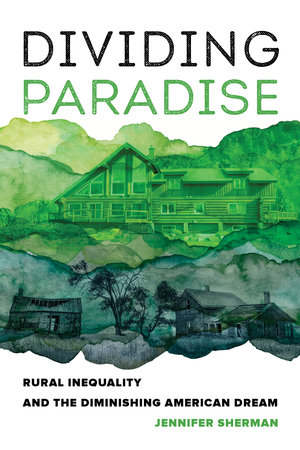By Jennifer Sherman, author of Dividing Paradise: Rural Inequality and the Diminishing American Dream
In the wake of the COVID-19 pandemic, rural communities across the U.S. have been experiencing what has been labeled the “Zoomtown” effect: real estate booms fueled by remote workers buying second homes in and/or relocating to rural communities. For many, the pandemic has at least temporarily called into question whether cities are healthy environments for themselves and their families. Some are chasing a longtime dream of living a “simpler” life or being closer to nature. Some are temporarily escaping the high-density spaces where the disease first emerged and spread rapidly. High-amenity rural communities are experiencing particularly rapid growth, which for many is an acceleration of trends that were already in place prior to the pandemic.
For the rural communities, this flood of new residents is often a mixed blessing. Despite bringing new resources and experiences, the rapid influx of outsiders with different cultural, social, and socioeconomic backgrounds can destabilize small, cohesive, and homogenous communities in multiple ways. The most obvious and problematic result is rising housing costs due to increased demand and the higher prices urban in-migrants are able to pay. These dynamics can make both home rental and ownership prohibitively expensive for lower income populations. Gentrification can further change the nature of local businesses and services, often undermining local cultural norms and traditions and alienating longtime residents within their own communities.
Newcomers rarely enter rural communities with the intention to disenfranchise local populations, and often bring new ideas, energy, and skills that can help communities to adapt to current and future challenges. However, urban in-migrants also often bring unexamined judgments and negative impressions of rural populations as unsophisticated and uneducated, and unworthy of their own time and concern.
In my new book, Dividing Paradise: Rural Inequality and the Diminishing American Dream, I chronicle some of the unanticipated outcomes of this type of urban-to-rural migration in a high-amenity Western community, including gentrification and marginalization of old-timer populations, as well as the phenomenon I call “class blindness.”
I define class blindness as the tendency for those with social class privilege to be blind to their own advantages and to their impacts on less-advantaged populations around them. Similar to the phenomenon of color-blind racism, it consists of failures to acknowledge the different ways that advantages of financial, social, educational, and cultural resources make navigating labor, healthcare, childcare, and housing markets easier for some people than for others. The failure to recognize class-based differences in resources and the unequal access to power and opportunities that they create undermines empathy and compassion for others’ struggles and weakens abilities to help the less advantaged.
In the rural Northwestern community that I studied, more recent in-migrants tend to have significantly higher levels of wealth and income, education, and social and cultural capital than the community’s old-timers. These resources help them to navigate structural lacks of health care and child care, and to outcompete local populations in labor and housing markets. Yet their failure to recognize differential access to real and symbolic resources results in the tendency to ascribe old-timers’ struggles to personal failures versus structural inequities. For example, rather than recognizing the roles that educational attainment and social network ties play in helping them navigate a tight labor market, many suggested that those who can’t find work are lazy, drug-addicted, or otherwise dysfunctional. Similarly, rather than acknowledging the role of personal wealth in attaining housing or in surviving comfortably on low-wage jobs, many argued that those who struggled had made poor personal choices or were simply unwilling to work hard.
Without knowing their new neighbors well, in-migrants made many negative assumptions about old-timers that allowed them to further justify withholding resources from them. This included the tendency to offer jobs, housing, social connections, and power positions within the community to others most like themselves, while systematically denying these opportunities to those they considered to be unworthy. Over time these dynamics resulted in a bifurcated community in which one group monopolized power, resources, and opportunities, and the other was increasingly marginalized and disadvantaged.
As more and more ex-urbanites choose to enter rural housing markets like the one I studied, these issues will intensify. Potential solutions are manifold and complex, requiring changes at multiple levels. On the large scale, public policies that support all families and adults, such as health care, childcare, housing support, and living wages can help to diminish the gap between those with abundant resources and life opportunities and those without. On the community scale, I found that charitable and aid efforts that work to build connections between more- and less-advantaged residents can help build trust, understanding, and empathy while simultaneously providing necessary aid. Finally, on the individual scale, there is room for each of us to find ways in our daily lives to reach out to those least like us, to humanize our encounters, share our resources, and cross the social and cultural divides between us. Getting to know the neighbors who are least like us can help to significantly improve and enrich all of our lives and communities. Regardless of setting, we can diminish class blindness by becoming aware of privilege and checking assumptions about other groups of people. I encourage all with class privilege to try reaching out to people they encounter through shared social institutions like schools and churches, and to resist the instinct to only get to know those who seem the most similar to ourselves.
